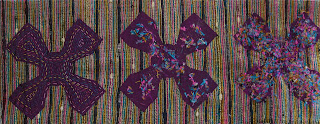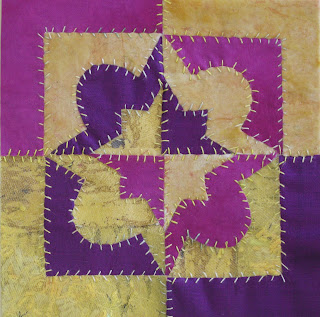I have installed this blog for the online courses Distant Stitch by City and Guilds, certificate in embroidery My tutor is Sian Martin.
Sonntag, 6. Februar 2011
M 1, chapter 11, image 21 and 22
M 1, chapter 11, image 17, 18, 19 and 20
M1, chapter 11, image 15 and 16 and worksheets for the last textile sample.
These images show two different ways of disintegrating or grow star shapes by using machine stitchery and hand stitchery. the two worksheets, one from paper and one from painted paper and fabric, are samples for the last textile samples and show the starshape which I shall use in postive and negative form in large and small. I played with these shapes and layes them in different postions to each other.
M1, chapter 10, worksheets and image 9 and 10
This is my positive and negative swapped shapes. I have used three different star shapes (image 10). The felt is a bonded fabric. I bonded a handycraft felt with a hand dyed commercial needle punched felt.
M1, chapter 10, image 8 and the worksheet
M1, chapter 10, image 6 and 7
Image 6 is my simple counterchange star shapefrom my painted paper and image 7 is the same shape made of fabric. I have used a simple insertion stitch.
M1, chapter 9, image 4
The upper starshape is made in chenille technic. The star beneath is a multicoloured ripple effect. I have stitched all the febriclayers together and then i cut them out more or less in the different layers.
M1, chapter 9, image 3
Here are two starshapes. One is stitched inside, the second is stitched outside and they are cut out.. I have used in both samples the same fabrics. The fabrics can you see on thr right side of the image.
M1,chapter 9, image 2 and the worksheet
This is a traditional starshape in Mola technic.
I made a paper sample before I started with the textile one.
I made a paper sample before I started with the textile one.
Abonnieren
Kommentare (Atom)

























